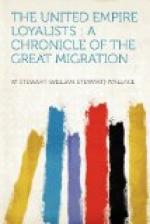Never at any other time perhaps have conditions been so favourable in Canada for land-grabbing and land-speculation as they were then. Owing to the large amount of land granted to absentee owners, and to the policy of free land grants announced by Simcoe, land was sold at a very low price. In some cases two hundred acre lots were sold for a gallon of rum. In 1791 Sir William Pullency, an English speculator, bought 1,500,000 acres of land in Upper Canada at one shilling an acre, and sold 700,000 acres later for an average of eight shillings an acre. Under these circumstances it was not surprising that many Americans, with their shrewd business instincts, flocked into the country.
It is clear, then, that a large part of the immigration which took place under Simcoe was not Loyalist in its character. From this, it must not be understood that the new-comers were not good settlers. Even Richard Cartwright confessed that they had ’resources in themselves which other people are usually strangers to.’ They compared very favourably with the Loyalists who came from England and the Maritime Provinces, who were described by Cartwright as ‘idle and profligate.’ The great majority of the American settlers became loyal subjects of the British crown; and it was only when the American army invaded Canada in 1812, and when William Lyon Mackenzie made a push for independence in 1837, that the non-Loyalist character of some of the early immigration became apparent.
CHAPTER XIII
THE LOYALIST IN HIS NEW HOME
The social history of the United Empire Loyalists was not greatly different from that of other pioneer settlers in the Canadian forest. Their homes were such as could have been seen until recently in many of the outlying parts of the country. In Nova Scotia and New Brunswick some of the better class of settlers were able to put up large and comfortable wooden houses, some of which are still standing. But even there most of them had to be content with primitive quarters. Edward Winslow was not a poor man, as poverty was reckoned in those days. Yet he lived in rather meagre style. He described his house at Granville, opposite Annapolis, as being ’almost as large as my log house, divided into two rooms, where we are snug as pokers.’ Two years later, after he had made additions to it, he proposed advertising it for sale in the following terms: ’That elegant House now occupied by the Honourable E. W., one of His Majesty’s Council for the Province of New Brunswick, consisting of four beautiful Rooms on the first Floor, highly finished. Also two spacious lodging chambers in the second story—a capacious dry cellar with arches &c. &c. &c.’ In Upper Canada, owing to the difficulty of obtaining building materials, the houses of the half-pay officers were even less pretentious. A traveller passing through the country about Johnstown in 1792 described Sir John Johnson’s house as ’a small country lodge, neat, but as the grounds are only beginning to be cleared, there was nothing of interest.’




